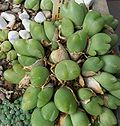| Gibbaeum | |
|---|---|
 | |
| Gibbaeum heathii | |
| Scientific classification | |
| Kingdom: | Plantae |
| Clade: | Tracheophytes |
| Clade: | Angiosperms |
| Clade: | Eudicots |
| Order: | Caryophyllales |
| Family: | Aizoaceae |
| Subfamily: | Ruschioideae |
| Tribe: | Ruschieae |
| Genus: | Gibbaeum Haw. ex N.E.Br. [1] [2] |
| Species [2] | |
17, see text | |
| Synonyms [2] | |
| |
Gibbaeum is a genus of about 17 species of small succulent plants of the family Aizoaceae, indigenous to the Little Karoo region of South Africa. The name "Gibbaeum" comes from the Latin gibbosus (hunchback)













